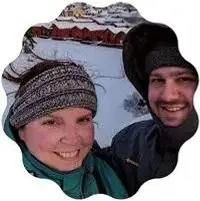7 Best Hot Springs In Hawaii
North America, Hawaii, United States / March 11, 2025 / 9 comments
When it comes to hot springs, many assume that the tectonic and volcanic action on Hawaii must mean that the region is “swimming” with hot springs. Well, that’s not exactly the case.
While there are no traditional hot springs in Hawaii as they are typically found on land, you can find several warm springs and tide pools that make for an enjoyable experience.
Unfortunately, many of these natural attractions were destroyed by the volcano eruption in 2018, so you’ll need to do some research to find out about the locations that are still accessible.
In this article, we’ll take a look at what hot spring options still exist in Hawaii and how to best experience them for yourself.
This post contains affiliate links. This means if you purchase something from a link, I may make a small commission, at no cost to you. This helps me keep the site running and free.
If you like this post, be sure to sign up for my e-mail list for travel inspiration (and get your FREE budget printable), or connect with me on Facebook, Instagram, Twitter, or Pinterest.
Overview of the Best Hot Springs in Hawaii
Hawaii is home to several natural hot springs, also known as “hot ponds”, that offer a relaxing and rejuvenating experience. Here is our pick of the best hot springs in Hawaii that are still accessible:
- Pohoiki Warm Springs
- Queen’s Bath
- The Seven Sacred Pools of Oheo
- Olivine Pools
Hot springs in Hawaii that are no longer available:
- Ahalanui Hot Springs
- Kapoho Tide Pools
- Makapu’u Tide Pools
Travel Tip: Be sure to bring your reef-safe, eco-friendly sunscreen and your sand-free Tesalate towel!
Pohoiki Warm Springs, Hawai’i
Pohoiki Warm Springs is a unique natural hot spring located on the eastern side of Hawaii’s Big Island. It is created by volcanic activity and heated with thermal energy from the Earth’s core, giving it a temperature that usually sits around 106°F (41°C).
The hot spring is surrounded by tropical trees and its entrance points directly out to the ocean, making for a great view.
It is free to access, so it’s a great spot for swimming, relaxing, and soaking up some of the island’s natural beauty. There are also bathroom facilities located nearby for convenience.
The history behind Pohoiki Warm Springs dates back thousands of years and its name comes from one of the springs once located in the area. The last major eruption at Pohoiki occurred in 2018 and since then, the place has become even more popular as visitors flock to experience its healing waters and amazing views.


Queen’s Bath, Kaua’i
Despite its name, Queen’s Bath is open to everyone, not just royalty! There’s no entrance fee required so it’s a great way to enjoy some fun in the sun without breaking the bank.
However, one should be aware that its location near the ocean access can prove dangerous during high surf days so caution should be exercised if visiting then.
Its waters are kept warm all year round thanks to the geothermal currents that flow through it, and its crystal clear blue waters offer stunning views of the surrounding area. Its beauty is further enhanced by the fact that it is surrounded by lava rock formations.
The pool itself is large enough for multiple people to swim and explore at once, and there is plenty of fish in its waters which makes it a great spot for snorkeling. It also offers plenty of room to relax and take in stunning views.

The Seven Sacred Pools of Oheo, Oahu
The Seven Sacred Pools of Oheo, also known as the Oheo Gulch, is an iconic natural formation located in east Maui on the Road to Hana.
This deeply spiritual and tranquil setting consists of a series of freshwater pools connected by cascading falls, all spilling into the Pacific Ocean. Each pool is surrounded by lush rainforest and spectacular rock formations that make this area truly breathtaking.
The pools were formed over thousands of years, as water from the Palikea Stream cut through igneous rock on its journey to the sea. As the sun heats up this flowing river water, it gradually fills each successive pool with warm water that is perfect for swimming or simply floating peacefully.
Oheo Gulch is part of Haleakala National Park, so if you purchase your tickets at Haleakala Summit you can access both attractions with one receipt.
There is a nominal fee per car when you enter either park, but it’s well worth it. It is located 15 minutes away from Hana along Highway 31.

Olivine Pools, Maui
The Olivine Pools in Hawaii are a truly unique experience for visitors to enjoy. Located on the back side of West Maui, Olivine Pools are accessible via a 0.4-mile out-and-back trail near Wailuku. The pristine tidepools offer swimming amongst hardened barren lava that has been formed by years of ocean waves crashing against the shore.
Birders and hikers alike can appreciate the beauty and solitude of the natural pools, which are filled with crystal-clear water. The waters are known for their vibrant colors, ranging from bright greens to deep blues and turquoise, due to the deposits of olivine particles (naturally occurring minerals) in them, which is where they get their namesake from.
Those who visit the Olivine Pools can also enjoy some hiking nearby – there’s plenty of short trails.

Ahalanui Hot Springs, Hawai’i
Ahalanui Hot Springs, located on the eastern coast of Hawaii’s Big Island (like Poihoiki), was a popular destination for locals and tourists alike. It was a man-made pool filled with geothermally heated seawater that is protected from the ocean by a rock wall. The hot spring is also known as Puʻalaʻa County Park, and is part of the Puna district of the Big Island.
During its peak, Ahalanui was used as a local gathering place for celebrations, such as weddings and birthdays. However, after the 2018 Kilauea eruption that inundated much of the area with lava flows, Ahalanui was closed due to safety concerns.

Kapoho Tide Pools, Hawai’i
The Kapoho Tide Pools in Hawaii are truly unique and special place. Located on the eastern coast of the Big Island, these pools are a series of natural hot springs fed by geothermally heated seawater.
Surrounded by coral, they are home to exotic marine life like sea stars, sponges, anemones, and more. Visitors can take a short walk to get there and enjoy the natural beauty of the area.
Although it was previously free to access, unfortunately, people cannot swim in the tide pools since the 2018 eruption of Kīlauea devastated much of the surrounding region.
Despite this setback, many still visit just to take in the stunning scenery and observe some of Hawaii’s incredible wildlife. It’s also popular among photographers and filmmakers who come to capture its beauty from both above and below the water.

Makapu’u Tide Pools, Oahu
Makapu’u Tide Pools in Hawaii are a hidden gem on the eastern coast of Oahu, nestled among volcanic rocks and offering stunning views of the Pacific Ocean. The natural pools are fed by seawater and heated by the sun, making it a great spot for swimming or exploring during low tide.
Unfortunately, access to the pools has been closed since 2018 due to hazardous conditions caused by an eruption in the area. Nevertheless, visitors can still enjoy the nearby beach and its amazing views from afar.
Makapu’u Tide Pools offer something distinct from other Hawaii beaches – the opportunity to explore a unique ecosystem in its most natural form. With rock formations providing homes for crustaceans, fish, and other sea life, visitors get to experience an outdoor adventure that is both educational and exciting.

Final Thoughts
Hawaii is a paradise of natural wonders, and witnessing their beauty up close is truly special.
While the hot springs may not always be accessible due to volcanic eruptions and other natural disasters, taking a dip in the local warm springs or tide pools is a great way to enjoy Hawaii’s unique climate and aquatic ecosystems.
Save “Best Hot Springs in Hawaii” for Later
About the Author


9 responses to “7 Best Hot Springs In Hawaii”

Well I have been to Hawai’i so many times but most of these I never heard of!! Thank you for opening my eyes. Saving for my next visit.

I’ve never really thought about Hawaii having hot springs, but with all the volcanic activity, it makes sense! These all look so beautiful, particularly the one with the waterfalls.

This would be a dream road trip, love nature’s spas around the world

I didn’t even realize that Hawaii had hot springs, and I have no idea why more people don’t put them on a Hawaii itinerary. These all sound fabulous! My husband and I are heading to Maui this year, so I will have to put the one on the Road to Hana on my list of places to check out 🙂

Your post brought back such wonderful memories of Hawaii. I didn’t get to visit any springs but next trip!

this was an interesting post, other than the seven sacred pools, I wasn’t aware of these other hot springs in Hawaii.

Now this is what I call a holiday! What a gorgeous place to chill. And with a view in nature. I’d love to visit!

These all look so nice! I wish I had read this a bit earlier as I was just in Maui, but it’s also good to have an excuse to go back, right? I like the foresty Pohoiki Warm Springs or Oheo Gulch, but it could be fun to try a more exposed swim at Queen’s Bath. Someday!

Never heard of any of these hot springs before so thanks for sharing!












Leave a Reply